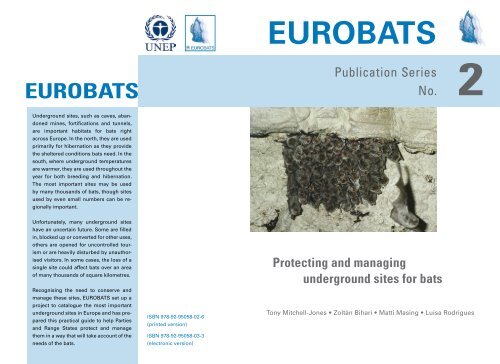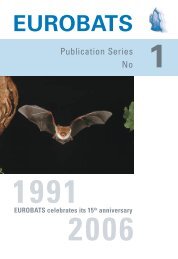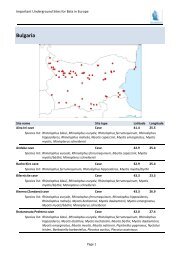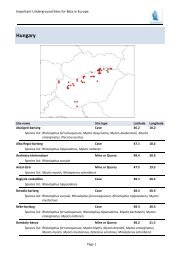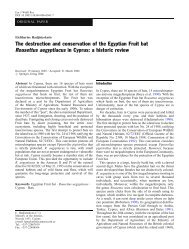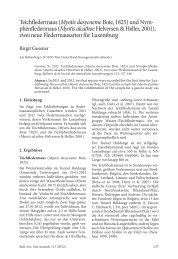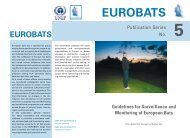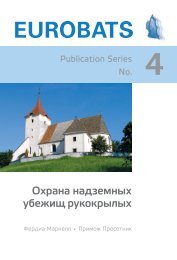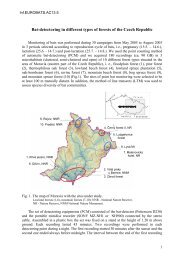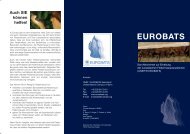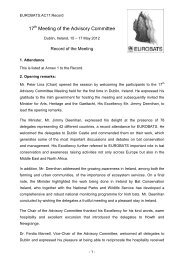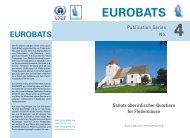Protecting and managing underground sites for bats, 3rd ... - Eurobats
Protecting and managing underground sites for bats, 3rd ... - Eurobats
Protecting and managing underground sites for bats, 3rd ... - Eurobats
You also want an ePaper? Increase the reach of your titles
YUMPU automatically turns print PDFs into web optimized ePapers that Google loves.
EUROBATS<br />
Underground <strong>sites</strong>, such as caves, aban-<br />
doned mines, <strong>for</strong>tifications <strong>and</strong> tunnels,<br />
are important habitats <strong>for</strong> <strong>bats</strong> right<br />
across Europe. In the north, they are used<br />
primarily <strong>for</strong> hibernation as they provide<br />
the sheltered conditions <strong>bats</strong> need. In the<br />
south, where <strong>underground</strong> temperatures<br />
are warmer, they are used throughout the<br />
year <strong>for</strong> both breeding <strong>and</strong> hibernation.<br />
The most important <strong>sites</strong> may be used<br />
by many thous<strong>and</strong>s of <strong>bats</strong>, though <strong>sites</strong><br />
used by even small numbers can be re-<br />
gionally important.<br />
Un<strong>for</strong>tunately, many <strong>underground</strong> <strong>sites</strong><br />
have an uncertain future. Some are filled<br />
in, blocked up or converted <strong>for</strong> other uses,<br />
others are opened <strong>for</strong> uncontrolled tour-<br />
ism or are heavily disturbed by unauthor-<br />
ised visitors. In some cases, the loss of a<br />
single site could affect <strong>bats</strong> over an area<br />
of many thous<strong>and</strong>s of square kilometres.<br />
Recognising the need to conserve <strong>and</strong><br />
manage these <strong>sites</strong>, EUROBATS set up a<br />
project to catalogue the most important<br />
<strong>underground</strong> <strong>sites</strong> in Europe <strong>and</strong> has pre-<br />
pared this practical guide to help Parties<br />
<strong>and</strong> Range States protect <strong>and</strong> manage<br />
them in a way that will take account of the<br />
needs of the <strong>bats</strong>.<br />
ISBN 978-92-95058-02-6<br />
(printed version)<br />
ISBN 978-92-95058-03-3<br />
(electronic version)<br />
EUROBATS<br />
Publication Series<br />
No.<br />
<strong>Protecting</strong> <strong>and</strong> <strong>managing</strong><br />
<strong>underground</strong> <strong>sites</strong> <strong>for</strong> <strong>bats</strong><br />
2<br />
Tony Mitchell-Jones • Zoltán Bihari • Matti Masing • Luísa Rodrigues
Mitchell-Jones, A. J., Bihari, Z., Masing, M. & Rodrigues, L. (2007): <strong>Protecting</strong><br />
<strong>and</strong> <strong>managing</strong> <strong>underground</strong> <strong>sites</strong> <strong>for</strong> <strong>bats</strong>. EUROBATS Publication Series No. 2<br />
(English version). UNEP / EUROBATS Secretariat, Bonn, Germany, 38 pp.<br />
Produced by UNEP / EUROBATS<br />
Coordinator Christine Boye / EUROBATS Secretariat<br />
Editors Christine Boye, Tine Meyer-Cords<br />
Layout Claudia Schmidt-Packmohr<br />
3 rd , updated version 2010 — © 2007, 2008, 2010 Agreement on the Conservation of Populations<br />
of European Bats (UNEP / EUROBATS).<br />
This publication may be reproduced in whole or in part <strong>and</strong> in any <strong>for</strong>m <strong>for</strong> educational or<br />
non-profit purposes without special permission from the copyright holder, provided acknowledgement<br />
of the source is made. UNEP / EUROBATS would appreciate receiving a copy of any<br />
publication that uses this publication as a source.<br />
No use of this publication may be made <strong>for</strong> resale or <strong>for</strong> any other commercial purpose whatsoever<br />
without prior permission in writing from UNEP / EUROBATS.<br />
The boundaries shown on the maps in this publication do not imply official endorsement or<br />
acceptance by the United Nations.<br />
We would like to express our gratitude to the Department<br />
<strong>for</strong> Environment, Food <strong>and</strong> Rural Affairs (Defra),<br />
UK, <strong>and</strong> the Ministry of Agriculture, Nature <strong>and</strong> Food<br />
Quality, Department of Nature, The Netherl<strong>and</strong>s, <strong>for</strong><br />
their funding without which this publication would not<br />
have been possible.<br />
Copies of this publication are available from the<br />
UNEP / EUROBATS Secretariat<br />
United Nations Campus<br />
Hermann-Ehlers-Str. 10<br />
53113 Bonn, Germany<br />
Tel (+49) 228 815 2421<br />
Fax (+49) 228 815 2445<br />
E-mail euro<strong>bats</strong>@euro<strong>bats</strong>.org<br />
Web www.euro<strong>bats</strong>.org<br />
ISBN 978-92-95058-02-6 (printed version)<br />
ISBN 978-92-95058-03-3 (electronic version)<br />
Cover photo: Schreiber’s bent-winged <strong>bats</strong><br />
(Miniopterus schreibersii), Cyprus.<br />
UNEP promotes<br />
environmentally sound practices<br />
globally <strong>and</strong> in its own activities. This<br />
publication is printed on chlorine-free, FSC-<br />
certified, 60% recycled paper, using environmentally<br />
friendly practices. Our distribution policy aims to<br />
reduce UNEP's carbon footprint.<br />
<strong>Protecting</strong> <strong>and</strong> <strong>managing</strong> <strong>underground</strong> <strong>sites</strong> <strong>for</strong> <strong>bats</strong><br />
Underground <strong>sites</strong> important <strong>for</strong> <strong>bats</strong> in Europe as identified by EUROBATS Parties<br />
<strong>and</strong> Range States. The map shows the location of <strong>sites</strong> in the database at 1/11/06.
Contents<br />
<strong>Protecting</strong> <strong>and</strong> <strong>managing</strong> <strong>underground</strong> <strong>sites</strong> <strong>for</strong> <strong>bats</strong><br />
1 Introduction 5<br />
2 How <strong>bats</strong> use <strong>underground</strong> <strong>sites</strong> 6<br />
2.1 Characteristics of <strong>underground</strong> <strong>sites</strong> 6<br />
2.2 Uses of <strong>underground</strong> <strong>sites</strong> 6<br />
3 Threats to <strong>underground</strong> <strong>sites</strong> 8<br />
3.1 Excessive disturbance 8<br />
3.2 Destruction, maintenance or change of use 8<br />
4 Site protection 9<br />
4.1 Legal protection 9<br />
4.2 Working with others 9<br />
4.2.1 Working with caving clubs <strong>and</strong> other <strong>underground</strong> visitors 9<br />
4.2.2 Site grading 10<br />
4.2.3 Conservation code 10<br />
4.2.4 Site notices 12<br />
4.3 Physical protection measures 12<br />
4.3.1 General considerations 12<br />
4.3.2 Grilles 13<br />
4.3.3 Fences 23<br />
4.3.4 Water barriers 24<br />
5 Site management 25<br />
5.1 Management of the <strong>underground</strong> environment 25<br />
5.1.1 Rock falls or collapses <strong>underground</strong> 25<br />
5.1.2 Poisonous gas 25<br />
5.2 Management around the entrance 25<br />
5.2.1 Rock falls <strong>and</strong> collapses 25<br />
5.2.2 Livestock <strong>and</strong> large mammals 26<br />
5.2.3 Vegetation 26<br />
5.2.4 Lighting 26<br />
5.2.5 Management of the surrounding habitat 26<br />
3
4<br />
EUROBATS Publication Series No. 2<br />
6 Creative conservation 28<br />
6.1 Manipulation of air flow <strong>and</strong> temperature 28<br />
6.2 Reopening of blocked <strong>sites</strong> 28<br />
6.3 Provision of additional roosting places 30<br />
6.4 Provision of new roosts 30<br />
6.4.1 Cave construction 30<br />
7 Monitoring 36<br />
7.1 Bat monitoring 36<br />
7.2 Physical condition 37<br />
Glossary 38<br />
Acknowledgements 38<br />
Photo credits 38<br />
Further reading 38<br />
1 Introduction<br />
This manual, produced by the EUROBATS<br />
Advisory Committee, provides guidance on<br />
all aspects of the conservation <strong>and</strong> manage-<br />
ment of <strong>underground</strong> <strong>sites</strong> used by <strong>bats</strong>.<br />
<strong>Protecting</strong> <strong>underground</strong> <strong>sites</strong> requires<br />
two elements in combination: legal <strong>and</strong><br />
administrative arrangements, which help<br />
manage the way in which people under-<br />
st<strong>and</strong> the value <strong>and</strong> sensitivity of the site,<br />
<strong>and</strong> physical protection measures, which<br />
provide security against intruders. Both<br />
elements need to be considered together<br />
when devising a site management plan or<br />
proposal.<br />
Legal <strong>and</strong> administrative structures, as<br />
well as the practice of nature conservation,<br />
vary across Europe, so, when dealing with<br />
these issues, this guide can only give guid-<br />
<strong>Protecting</strong> <strong>and</strong> <strong>managing</strong> <strong>underground</strong> <strong>sites</strong> <strong>for</strong> <strong>bats</strong><br />
ing principles which will need to be adapt-<br />
ed to local circumstances. Conversely, the<br />
provision of physical protection measures,<br />
such as the use of fences <strong>and</strong> grilles (gates)<br />
varies rather less, so some more detailed<br />
guidance can be given. Where possible, we<br />
have drawn on the practical experiences of<br />
bat conservationists from across Europe to<br />
provide a range of tried <strong>and</strong> tested protec-<br />
tion structures.<br />
For the purpose of this manual, the term<br />
<strong>underground</strong> <strong>sites</strong> includes caves <strong>and</strong> all<br />
man-made structures that mimic the envi-<br />
ronmental conditions found in caves. This<br />
includes, <strong>for</strong> example, ab<strong>and</strong>oned mines of<br />
all sorts, tunnels, cellars, ice-houses, stor-<br />
age facilities <strong>and</strong> military installations <strong>and</strong><br />
<strong>for</strong>tifications.<br />
5
6<br />
EUROBATS Publication Series No. 2<br />
2 How <strong>bats</strong> use <strong>underground</strong> <strong>sites</strong><br />
2.1 Characteristics of <strong>underground</strong> <strong>sites</strong><br />
A key characteristic of <strong>underground</strong> <strong>sites</strong><br />
is that they are protected from the external<br />
environment, so that both temperature <strong>and</strong><br />
humidity are buffered against rapid change.<br />
In large <strong>underground</strong> areas, where there<br />
is little air-flow, the temperature will not<br />
vary much throughout the year <strong>and</strong> will be<br />
close to the mean annual temperature <strong>for</strong><br />
the area. The main modifying factors which<br />
determine the temperature, <strong>and</strong> the extent<br />
to which it reflects changes in the external<br />
temperature, are proximity to the entrance<br />
<strong>and</strong> amount <strong>and</strong> direction of airflow. The<br />
configuration of the site can also affect the<br />
internal micro-climate. For example, domes<br />
in the roof can collect <strong>and</strong> hold rising warm<br />
air, leading to an elevated temperature,<br />
whereas low parts of systems can act as<br />
sinks <strong>for</strong> cold air, leading to a lower tem-<br />
perature.<br />
2.2 Uses of <strong>underground</strong> <strong>sites</strong><br />
Be<strong>for</strong>e they began to use buildings, <strong>bats</strong><br />
used two main types of roost, trees <strong>and</strong><br />
caves (including rock crevices). Whereas<br />
tree roosts have a short life, probably short-<br />
er than the lifespan of most <strong>bats</strong>, caves pro-<br />
vide permanent roosts which can be used<br />
by many generations of <strong>bats</strong>. This difference<br />
in lifetime availability is reflected in the way<br />
in which <strong>bats</strong> use their roosts, even when<br />
these are now in buildings. Tree-roosting<br />
species, such as Nyctalus noctula, tend to<br />
move between many roosts at short inter-<br />
vals, whereas cave-roosting species, such<br />
as the Rhinolophids, tend to remain faithful<br />
to the same <strong>sites</strong> throughout their life.<br />
Bats can use <strong>underground</strong> roosts <strong>for</strong> all<br />
stages of their annual cycle, depending on<br />
the temperature. In northern Europe, where<br />
mean annual temperatures are low, these<br />
<strong>sites</strong> are used predominantly <strong>for</strong> hiberna-<br />
tion, with breeding rather rarely recorded.<br />
Species such as the Rhinolophids, which<br />
historically would have bred <strong>underground</strong>,<br />
have adopted the roofs of buildings, which<br />
provide higher temperatures. In southern<br />
Europe, the higher mean temperatures al-<br />
low a wider range of bat species to breed<br />
in <strong>underground</strong> <strong>sites</strong> as well as hibernate<br />
in them.<br />
Bats tend to prefer dynamic cave sys-<br />
tems, where there is a flow of air through<br />
the system <strong>and</strong> hence some variation in<br />
temperature. There are also species-speci-<br />
fic differences in the temperatures that <strong>bats</strong><br />
choose <strong>for</strong> hibernation. In simple dynamic<br />
systems, such as blind tunnels or horizon-<br />
tal passages, which rely on convection cur-<br />
rents, the size, configuration <strong>and</strong> aspect<br />
can affect the temperature within the site<br />
to a considerable degree. Convection will<br />
pull in warm air in summer <strong>and</strong> cold air in<br />
winter. Domes <strong>and</strong> recesses in the roof can<br />
trap warm air, <strong>and</strong> cold air can be trapped<br />
in areas lower than the entrance. Figure 1<br />
gives some examples. The surrounding<br />
vegetation <strong>and</strong> topography are also very<br />
important as <strong>bats</strong> require cover around<br />
the site access. Non-dynamic systems with<br />
no air movement tend to be too warm <strong>for</strong><br />
hibernation, though they may be used as<br />
temporary summer roosts.<br />
Warming effect<br />
<strong>Protecting</strong> <strong>and</strong> <strong>managing</strong> <strong>underground</strong> <strong>sites</strong> <strong>for</strong> <strong>bats</strong><br />
Cooling effect<br />
Warm air current<br />
Cool air current<br />
Figure 1. Air flow in <strong>underground</strong> <strong>sites</strong>. The deep <strong>underground</strong> temperature is close to the<br />
seasonal average temperature <strong>for</strong> the area. In summer, when the external temperature<br />
is higher than the <strong>underground</strong> temperature, warm air entering the site cools, becomes<br />
denser <strong>and</strong> flows out downhill (top). In winter, the airflow is reversed as cold air is warmed<br />
<strong>and</strong> rises (bottom). Domes in the roof are always the warmest places.<br />
7
8<br />
EUROBATS Publication Series No. 2<br />
3 Threats to <strong>underground</strong> <strong>sites</strong><br />
3.1 Excessive disturbance<br />
Although <strong>bats</strong> can tolerate a small amount<br />
of disturbance during breeding or hibernati-<br />
on <strong>and</strong> can apparently get used to a low le-<br />
vel of human activity, excessive disturbance<br />
will cause <strong>bats</strong> to ab<strong>and</strong>on a site or can be a<br />
cause of mortality. In some extensive cave<br />
systems, hibernating <strong>and</strong> breeding <strong>bats</strong><br />
may co-exist with cavers, who are aware of<br />
their vulnerability <strong>and</strong> take reasonable care<br />
not to disturb them. However, <strong>bats</strong> in many<br />
other <strong>sites</strong> have been adversely affected<br />
<strong>and</strong> some previously important <strong>sites</strong> have<br />
been ab<strong>and</strong>oned. The increasing use of a<br />
growing number of <strong>sites</strong> by outdoor pur-<br />
suits centres, adventure holiday groups <strong>and</strong><br />
unregulated tourism is also a cause <strong>for</strong> con-<br />
cern, as members of such parties generally<br />
have less underst<strong>and</strong>ing of the impact of<br />
humans on these <strong>sites</strong> <strong>and</strong> their fauna than<br />
members of specialist clubs. Frequency of<br />
visits is also a problem: outdoor centres<br />
generally operate throughout the week, so<br />
that visits to <strong>sites</strong> by relatively large parties<br />
of inexperienced people can be frequent.<br />
Some <strong>sites</strong> are readily accessible with-<br />
out any special equipment or preparation.<br />
Here, casual disturbance by curious tourists<br />
can be a problem, as can v<strong>and</strong>alism, the<br />
lighting of fires, the dumping of toxic waste<br />
or even the deliberate killing of <strong>bats</strong>.<br />
3.2 Destruction, maintenance or change<br />
of use<br />
Subterranean <strong>sites</strong> can suffer from a vari-<br />
ety of operations that can affect their use<br />
by <strong>bats</strong>. Safety considerations <strong>and</strong> concern<br />
over legal liability have persuaded many<br />
local administrations, national mining au-<br />
thorities or l<strong>and</strong> owners to seal disused<br />
shafts <strong>and</strong>, in some cases, block caves or<br />
passages in ways that make them inacces-<br />
sible to <strong>bats</strong>. Even if <strong>sites</strong> remain accessi-<br />
ble, partial blocking or obstruction can alter<br />
the airflow, leading to temperature changes<br />
within the system. In some areas the loss<br />
of potential hibernation <strong>sites</strong> is continuing<br />
at a significant rate. Tunnels have been re-<br />
paired, converted to storage areas or rifle<br />
ranges, or reopened <strong>for</strong> their original use;<br />
caves have been opened <strong>for</strong> public access<br />
as show caves, <strong>and</strong> caves <strong>and</strong> mines have<br />
been quarried away as part of commercial<br />
quarrying operations. Even if a cave or mine<br />
is to remain open, gating or grilling in an in-<br />
appropriate way can also affect the <strong>bats</strong>, so<br />
the SNCO 1 should always be consulted.<br />
Even quite small changes to the topog-<br />
raphy of a site, both inside <strong>and</strong> outside,<br />
can have far-reaching effects on its suitabil-<br />
ity <strong>for</strong> <strong>bats</strong>, mainly by altering the air-flow<br />
through the system <strong>and</strong> hence the tem-<br />
perature <strong>and</strong> humidity. Some changes, if<br />
carefully planned, can benefit the <strong>bats</strong>, but<br />
others can certainly degrade the usefulness<br />
of the site.<br />
1 Statutory nature conservation organisation<br />
– see Glossary, p.38.<br />
4 Site protection<br />
4.1 Legal protection<br />
Bats have some degree of protection in eve-<br />
ry country in Europe, though the details of<br />
this, <strong>and</strong> the extent to which the legislation<br />
is en<strong>for</strong>ced is very variable.<br />
In the European Union, protection is<br />
given to <strong>bats</strong> <strong>and</strong> the places they use <strong>for</strong><br />
breeding or resting by Council Directive<br />
92/43/EEC of 21 st May 1992 on the Conser-<br />
vation of Natural Habitats <strong>and</strong> of Wild Fauna<br />
<strong>and</strong> Flora. All species of <strong>bats</strong> are on Annex IV<br />
Animal <strong>and</strong> Plant Species of Community In-<br />
terest in need of Strict Protection <strong>and</strong> some<br />
are also on Annex II, requiring the designa-<br />
tion of Special Areas of Conservation. Mem-<br />
ber States are obliged to translate these<br />
requirements into their own national legis-<br />
lation which complies with the Directive.<br />
Many European countries are also sig-<br />
natories to the Bern Convention, which re-<br />
quires strict protection measures <strong>for</strong> spe-<br />
cies listed on Appendix II. This includes all<br />
<strong>bats</strong> except Pipistrellus pipistrellus (sensu<br />
lato), which is listed on Appendix III. Details<br />
may be found on the website of the Bern<br />
Convention.<br />
Those countries which are Parties to the<br />
Agreement on the Conservation of Popula-<br />
tions of European Bats (UNEP/EUROBATS)<br />
assumed special obligations <strong>for</strong> the con-<br />
servation of <strong>bats</strong> <strong>and</strong> their habitats. This<br />
included a recognition that protection <strong>and</strong><br />
monitoring of important <strong>underground</strong> <strong>sites</strong><br />
are essential <strong>for</strong> bat conservation.<br />
Most EUROBATS Parties have also joined<br />
the Bonn Convention (UNEP/CMS). This<br />
Convention lists all bat species on Appendix<br />
II, indicating that they are migratory species<br />
which may be subject to Agreements.<br />
<strong>Protecting</strong> <strong>and</strong> <strong>managing</strong> <strong>underground</strong> <strong>sites</strong> <strong>for</strong> <strong>bats</strong><br />
Many species of <strong>bats</strong> are red-listed by the<br />
IUCN because of their poor conservation<br />
status. Although listing does not carry any<br />
legal requirement <strong>for</strong> protection, it is used<br />
by many countries as an important criterion<br />
when deciding which species to protect.<br />
4.2 Working with others<br />
4.2.1 Working with caving clubs <strong>and</strong><br />
other <strong>underground</strong> visitors<br />
Patterns of l<strong>and</strong> ownership vary across<br />
Europe, with some <strong>underground</strong> places<br />
privately owned <strong>and</strong> others owned by<br />
the state. In many countries, however, or-<br />
ganised caving or mine history groups or<br />
clubs 2 have an important role in protecting<br />
such places <strong>and</strong> regulating the number of<br />
visitors. Access to many caves <strong>and</strong> mines<br />
is restricted <strong>for</strong> safety reasons, to keep out<br />
mineral collectors, to protect the under-<br />
ground features or to safeguard a water<br />
supply. Caving clubs may hold the keys to<br />
gates, grilles or fences <strong>and</strong> regulate the<br />
number of visitors according to an agree-<br />
ment with the owner or the state.<br />
Because caving clubs <strong>and</strong> other re-<br />
sponsible organisations have an interest<br />
in protecting the <strong>underground</strong> features,<br />
including fauna, of caves, it is very impor-<br />
tant that bat conservationists <strong>and</strong> these<br />
clubs work together <strong>and</strong> that <strong>underground</strong><br />
places are protected with the agreement<br />
of both parties.<br />
2 This includes organisations with an inte-<br />
rest in ab<strong>and</strong>oned mines, <strong>for</strong>tifications <strong>and</strong><br />
other <strong>underground</strong> structures.<br />
9
10<br />
EUROBATS Publication Series No. 2<br />
All caving clubs have systems <strong>for</strong> training<br />
their members to work in a safe way <strong>and</strong><br />
to protect the <strong>underground</strong> environment.<br />
This provides an important way <strong>for</strong> bat con-<br />
servationists to explain the vulnerability of<br />
<strong>bats</strong> to disturbance <strong>and</strong> the actions that ca-<br />
vers should take to protect them.<br />
4.2.2 Site grading<br />
To assist relations with caving organisati-<br />
ons, it is important that bat conservationists<br />
do not dem<strong>and</strong> unnecessary restrictions on<br />
the activities of cavers <strong>and</strong> that any restric-<br />
tions on where <strong>and</strong> when cavers can visit<br />
<strong>underground</strong> <strong>sites</strong> are fully justified <strong>and</strong><br />
explained. One way of doing this is to de-<br />
velop a grading system <strong>for</strong> caves. The way<br />
in which this is done will need to fit with the<br />
national approach to cave ownership <strong>and</strong><br />
exploitation, but a typical system would in-<br />
clude grades <strong>for</strong> <strong>sites</strong> with different levels<br />
Grade Bat interest Advice to cavers<br />
1 No known interest No restrictions on visiting. Report any bat<br />
sightings to bat contact.<br />
2 Small numbers of <strong>bats</strong> No restrictions on visiting. Follow the<br />
3 Large numbers of <strong>bats</strong> present<br />
seasonally<br />
4 Large numbers of <strong>bats</strong> present<br />
throughout the year<br />
of bat interest <strong>and</strong> hence different degrees<br />
of restriction on caving activities. An outli-<br />
ne example system is shown in the table<br />
below.<br />
4.2.3 Conservation code<br />
Developing a conservation code, setting out<br />
the reasons why <strong>bats</strong> need special care <strong>and</strong><br />
how visitors to <strong>underground</strong> <strong>sites</strong> should<br />
behave, is an important step in developing<br />
relationships with other visitors to these<br />
<strong>sites</strong>. It is important too that batworkers<br />
should respect other conservation interests,<br />
such as rock, mud <strong>and</strong> flowstone <strong>for</strong>mations<br />
in caves <strong>and</strong> historical artefacts in mines<br />
<strong>and</strong> other artificial <strong>sites</strong>. An example con-<br />
servation code, based on one used in the<br />
UK, is shown on page 11. This may need to<br />
be adapted to local conditions, but most of<br />
the main elements about contact with <strong>bats</strong><br />
should be kept.<br />
conservation code.<br />
Seasonal restrictions on visiting agreed.<br />
Do not visit defined parts of the cave<br />
during the closed season, follow the<br />
conservation code at other times.<br />
Cave closed all year. Small parties of<br />
visitors may be permitted by agreement.<br />
A management plan can indicate limit to<br />
numbers <strong>and</strong> the routes to be used.<br />
<strong>Protecting</strong> <strong>and</strong> <strong>managing</strong> <strong>underground</strong> <strong>sites</strong> <strong>for</strong> <strong>bats</strong><br />
Example Bat Conservation Code<br />
Caves <strong>and</strong> mines, their <strong>for</strong>mations, artefacts <strong>and</strong> fauna, are all part of our national he-<br />
ritage. All visitors to <strong>underground</strong> <strong>sites</strong> should work to maintain these <strong>sites</strong> <strong>for</strong> current<br />
<strong>and</strong> future generations.<br />
Always follow the safety <strong>and</strong> conservation codes published by the caving <strong>and</strong> min-<br />
ing history organisations <strong>and</strong> liaise with local groups over access <strong>and</strong> safety require-<br />
ments.<br />
Remember also that <strong>bats</strong> need your help to survive the winter. Most hibernating<br />
<strong>bats</strong> are very difficult to see as many squeeze into cracks <strong>and</strong> crevices. Just because<br />
you cannot see them does not mean they are not there!<br />
Those visiting known bat <strong>sites</strong> <strong>for</strong> purposes such as recreation, are asked to ob-<br />
serve the voluntary conservation code <strong>and</strong> respect any special restrictions that have<br />
been placed on particularly important bat <strong>sites</strong>. Because disturbance can be so dam-<br />
aging, the study of <strong>bats</strong> in <strong>underground</strong> <strong>sites</strong> is limited to appropriately trained <strong>and</strong><br />
authorised people. Such authorisations are issued <strong>for</strong> controlled, carefully considered<br />
basic survey <strong>and</strong> monitoring <strong>and</strong> occasionally <strong>for</strong> scientific research.<br />
Contact with <strong>bats</strong><br />
• Do not touch or h<strong>and</strong>le <strong>bats</strong> (unless licensed <strong>and</strong> then only when essential). Also<br />
beware of dislodging <strong>bats</strong> from their roosting position particularly when you are<br />
moving through low passages.<br />
• Do not photograph roosting <strong>bats</strong>. Flashguns can be very disturbing.<br />
• Do not warm up hibernating <strong>bats</strong>. This can arouse them. Try not to st<strong>and</strong> under-<br />
neath them or linger in confined spaces as even your body heat is sufficient to cause<br />
arousal.<br />
• Do not shine bright lights on <strong>bats</strong>. Both the light <strong>and</strong> the heat can trigger arousal.<br />
• Do not use carbide lamps or other open flames in bat roosts. Carbide lamps are<br />
particularly undesirable because of the heat <strong>and</strong> fumes.<br />
• Do not smoke or make excessive noise <strong>underground</strong>. Any strong stimulus, includ-<br />
ing cosmetics with strong smells, can arouse <strong>bats</strong>.<br />
• Do not take large parties into bat roosts in winter. Rescue practices should also be<br />
avoided when <strong>bats</strong> are present.<br />
• Do not light fires in the entrance to <strong>underground</strong> places as the smoke may arouse<br />
the <strong>bats</strong>.<br />
• Do seek advice be<strong>for</strong>e blasting or digging. Explosives can cause problems both<br />
from the blast itself <strong>and</strong> from the subsequent fumes. In known bat <strong>sites</strong> blasting<br />
should be limited to the time when <strong>bats</strong> are not present or to areas not known to be<br />
used by <strong>bats</strong>. Digging operations may alter the microclimate of bat roosts.<br />
Source: Adapted from Hutson, A. M., Mickleburgh, S. & Mitchell-Jones, A. J. (1995):<br />
Bats <strong>underground</strong>: a conservation code. Bat Conservation Trust, London.<br />
11
12<br />
EUROBATS Publication Series No. 2<br />
4.2.4 Site notices<br />
Although bat conservationists often prefer<br />
to keep the location of important <strong>sites</strong> se-<br />
cret, it can be helpful to place notices be-<br />
hind grilles or fences to explain why the<br />
site has been protected against unauthor-<br />
ised entry. This requires discussion with<br />
the l<strong>and</strong>owner <strong>and</strong> an assessment of the<br />
risk of v<strong>and</strong>alism. If there is concern about<br />
publicising the presence of the <strong>bats</strong>, an<br />
alternative approach is to put up a notice<br />
explaining that the site has been closed <strong>for</strong><br />
safety reasons. If the site is only protected<br />
<strong>for</strong> part of the year (perhaps by agreement<br />
with caving organisations), a notice should<br />
explain this <strong>and</strong> indicate when the roost is<br />
open to visitors.<br />
Some important caves are subject to dis-<br />
turbance by casual tourists because their<br />
entrances are close to a signposted public<br />
footpath. Rerouting the path <strong>and</strong> relocat-<br />
ing the signposts can give some protection<br />
from disturbance.<br />
4.3 Physical protection measures<br />
4.3.1 General considerations<br />
The most frequently required conservation<br />
measure <strong>for</strong> caves <strong>and</strong> mines is physical<br />
protection against excessive disturbance.<br />
This is generally achieved by fitting a gril-<br />
le across the entrance which permits the<br />
free passage of <strong>bats</strong> but not people, though<br />
other measures such as security fencing<br />
may be needed in some cases. If a grille or<br />
fence is to be fitted, it is important to moni-<br />
tor bat numbers be<strong>for</strong>e <strong>and</strong> after fitting to<br />
check <strong>for</strong> any beneficial or adverse effects.<br />
Some species of <strong>bats</strong> react negatively to<br />
the presence of grilles. This is the case with<br />
Miniopterus schreibersii at all times of the<br />
year <strong>and</strong> Rhinolophus mehelyi, R. euryale<br />
Myotis myotis <strong>and</strong> M. blythii during the<br />
breeding season. Observations at <strong>sites</strong> in<br />
Portugal <strong>and</strong> France showed that:<br />
• at least in the short or medium term <strong>bats</strong><br />
ab<strong>and</strong>on gated caves,<br />
• flying speed decreased,<br />
• flying height decreased,<br />
• number of circles near the entrance in-<br />
creased, <strong>and</strong><br />
• the number of l<strong>and</strong>ings on the ceiling,<br />
walls or even on the gate increased.<br />
Taking these results into account, grilles co-<br />
vering the whole entrance are not a suitable<br />
measure to protect roosts that are used by<br />
large colonies of these species at the times<br />
referred to above; fences or other security<br />
measures should be used instead. Special<br />
care should always be taken when protec-<br />
ting <strong>sites</strong> used by summer colonies as the<br />
frequency with which <strong>bats</strong> pass through<br />
the grille is likely to be much higher than at<br />
<strong>sites</strong> that are used only during the winter.<br />
At summer <strong>sites</strong>, individual <strong>bats</strong> may pass<br />
through the grille several times per night<br />
whereas at hibernation <strong>sites</strong> they may only<br />
pass through the grille once or twice per<br />
month. Sites used <strong>for</strong> autumn swarming<br />
should be treated as summer <strong>sites</strong> because<br />
bat activity may be very high <strong>for</strong> a short pe-<br />
riod of the year.<br />
Grilles or fences must be carefully plan-<br />
ned if they are to be successful <strong>and</strong> a num-<br />
ber of points must be taken into account.<br />
• The regional or national nature conser-<br />
vation organisation (SNCO) must be con-<br />
sulted if the site is already used by <strong>bats</strong>.<br />
Grilles or fences have the potential to dam-<br />
age bat roosts if not correctly designed <strong>and</strong><br />
fitted, so advice must be sought on this. The<br />
SNCO may also wish to keep records.<br />
Grilles <strong>and</strong> fences can be expensive items<br />
<strong>and</strong> the SNCO may be able to assist with<br />
the cost of protecting known bat roosts <strong>and</strong><br />
suggest other sources of funding.<br />
• The species using a site throughout the<br />
year should be identified be<strong>for</strong>e protection<br />
is installed as some species are known to<br />
avoid flying through grilles so fences must<br />
be used instead. Summer as well as win-<br />
ter use should be taken into account, so<br />
these data may take some years to collect.<br />
Protection should not be installed at times<br />
when disturbance to <strong>bats</strong> is likely to result.<br />
• The impact of the grille or fence should be<br />
considered be<strong>for</strong>eh<strong>and</strong>. For very important<br />
<strong>sites</strong> this could be studied by using a tem-<br />
porary installation (e.g. a plastic grille). The<br />
level of use by <strong>bats</strong> (frequency of entry <strong>and</strong><br />
exit) should be checked after installation.<br />
• Permission must be sought from the<br />
l<strong>and</strong>owner <strong>and</strong> any tenants. A management<br />
agreement will help to set out responsibili-<br />
ties <strong>and</strong> any arrangements that have been<br />
made <strong>for</strong> access. Many owners will wel-<br />
come the installation <strong>and</strong> maintenance of<br />
a grille or fence, as this will help to reduce<br />
fears about safety <strong>and</strong> discourage trespass.<br />
Many conservation NGOs 3 have experience<br />
of such agreements <strong>and</strong> they may be wil-<br />
ling to help.<br />
• If the site is used by cavers, mine his-<br />
torians or similar groups, suitable arrange-<br />
ments <strong>for</strong> access by these groups must be<br />
negotiated be<strong>for</strong>e any work begins. Failure<br />
to do so will severely upset relations with<br />
responsible caving groups <strong>and</strong> may also<br />
3 Non-governmental organisations<br />
- see Glossary, p. 38.<br />
<strong>Protecting</strong> <strong>and</strong> <strong>managing</strong> <strong>underground</strong> <strong>sites</strong> <strong>for</strong> <strong>bats</strong><br />
lead to repeated damage or destruction of<br />
the grille or fence.<br />
• In high-risk urban <strong>sites</strong>, frequent or con-<br />
tinuous monitoring of a grille or fence may<br />
be possible using a professional security<br />
service, intruder detection systems or even<br />
CCTV.<br />
4.3.2 Grilles<br />
To be effective <strong>and</strong> secure, grilles should<br />
have horizontal bars of appropriate design<br />
<strong>and</strong> construction <strong>for</strong> the site. The following<br />
points should be taken into account:<br />
• The bar spacing is one of the most im-<br />
portant variables, as some <strong>bats</strong>, particularly<br />
horseshoes, are known to be reluctant to<br />
fly through narrow gaps. An air space of<br />
150 mm between horizontal bars is recom-<br />
mended, but this may be large enough to<br />
allow children through. There<strong>for</strong>e a slightly<br />
narrower spacing may be appropriate <strong>for</strong><br />
some <strong>sites</strong> or <strong>for</strong> some lower parts of a<br />
grille or where there are legal requirements<br />
<strong>for</strong> narrower spacing. A 130 mm gap seems<br />
to be a reasonable compromise <strong>for</strong> these ar-<br />
eas, though this spacing has been shown to<br />
affect the behaviour of Myotis <strong>bats</strong> at one<br />
swarming site in Britain.<br />
Grilled mine near Oslo, Norway. Used <strong>for</strong><br />
hibernation by small numbers of <strong>bats</strong>.<br />
13
14<br />
EUROBATS Publication Series No. 2<br />
When specifying the design, make sure that<br />
gap between bars is correctly described as<br />
engineers normally specify distances as<br />
between centres. For example, using 20 mm<br />
diameter rein<strong>for</strong>cing rod (radius = 10 mm) a<br />
150 mm air gap between bars would need<br />
a 170 mm gap between centres. This can be<br />
an expensive error!<br />
Grilled stone mine, Kent, UK. An important<br />
local site.<br />
• If horizontal bars are between 130-<br />
150 mm apart, vertical supports should be<br />
more widely spaced, though too wide a<br />
spacing will make the grille vulnerable to<br />
v<strong>and</strong>alism as the bars can be <strong>for</strong>ced apart<br />
more easily with tools such as car jacks.<br />
The exact spacing can be chosen to suit<br />
the size of the grille but should be in the<br />
range of 450-750 mm, with greater horse-<br />
shoes being given the larger spacing.<br />
Grilled chalk mine, Norfolk, UK.<br />
• All grilles should be constructed to per-<br />
mit access <strong>for</strong> authorised persons <strong>and</strong> <strong>for</strong><br />
safety. For small entrances, it may be most<br />
convenient to have the whole grille hinged<br />
<strong>and</strong> fitted on a sub-frame. This is particular-<br />
ly appropriate when doorways have to be<br />
grilled, as the sub-frame, hinges <strong>and</strong> lock<br />
can be concealed behind the door frame.<br />
Larger grilles will need to be fixed perma-<br />
nently in position <strong>and</strong> fitted with a door of<br />
at least 500 x 500 mm. This can be either<br />
hinged or sliding, depending on the circum-<br />
stances. If hinges are fitted, these should be<br />
of robust construction or concealed so that<br />
they cannot easily be cut through.<br />
Small grilled mine in sloping ground, UK.<br />
• The lock should be the weakest part of<br />
the grille so that a determined intruder may<br />
be tempted to break this relatively cheap<br />
<strong>and</strong> replaceable component rather than<br />
the grille itself. However, it should not be<br />
made too vulnerable <strong>and</strong> should be fitted<br />
so that it cannot easily be cut or levered off,<br />
though if the lock becomes seized or some-<br />
one damages it or fills it with epoxy resin it<br />
needs to be accessible <strong>for</strong> replacement. An<br />
alternative approach, which has been used<br />
in some situations, is to conceal the lock,<br />
so an attacker is unclear where to begin an<br />
assault.<br />
Large grilled mine, S. Limburg,<br />
The Netherl<strong>and</strong>s.<br />
• The construction material should be<br />
chosen to suit the vulnerability of the site<br />
<strong>and</strong> the finance available. For <strong>sites</strong> where<br />
there is a low risk of v<strong>and</strong>alism, a grade of<br />
mild steel may be an appropriate material.<br />
This is cheap but is not resistant to cutting<br />
<strong>and</strong> rusts rather quickly. Its main advan-<br />
tage is that the grille can be cut <strong>and</strong> fitted<br />
in situ <strong>and</strong> welded with portable equip-<br />
ment. For <strong>sites</strong> at higher risk or where the<br />
grille is to be prefabricated, some <strong>for</strong>m of<br />
toughened steel should be used <strong>for</strong> those<br />
Large-section grille, Lambertsberg, Germany.<br />
<strong>Protecting</strong> <strong>and</strong> <strong>managing</strong> <strong>underground</strong> <strong>sites</strong> <strong>for</strong> <strong>bats</strong><br />
parts of the grille that are most at risk. Re-<br />
in<strong>for</strong>cing rod (rebars) of 20 or 25 mm di-<br />
ameter is readily available <strong>and</strong> provides<br />
reasonable resistance to rust <strong>and</strong> to hack-<br />
saws. Tougher steels, such as manganese<br />
alloys, are available,but these are gener-<br />
ally expensive <strong>and</strong> some can be difficult to<br />
cut <strong>and</strong> weld. Seek advice about suitable<br />
grades from a steel supplier or fabricator.<br />
For particularly high-risk <strong>sites</strong>, it is prefer-<br />
able to construct the grille with 100 mm di-<br />
ameter steel tubes (thickness 8 mm) filled<br />
with concrete, pebbles <strong>and</strong> rein<strong>for</strong>cing rod<br />
(Figure 2). This is resistant to cutting with<br />
power tools <strong>and</strong> bending, even with a<br />
strong jack (see www.cpepesc.org/article.<br />
php3?id_article=354).<br />
High-security entrance door, Gauberg,<br />
Germany.<br />
Alternatively, grilles can be constructed<br />
from large-section angle iron which looks<br />
so massive as to deter attack, though care<br />
should be taken not to affect the air-flow.<br />
Small <strong>and</strong> medium-sized grilles can gener-<br />
ally be prefabricated out of a mixture of rod<br />
<strong>and</strong> angle <strong>and</strong> then trimmed to size, if nec-<br />
essary, on site. Large grilles may need to be<br />
prefabricated in sections <strong>and</strong> then bolted or<br />
welded together as they are fitted.<br />
15
16<br />
EUROBATS Publication Series No. 2<br />
• It is often advantageous to protect grilles<br />
against rust. This is preferably done by gal-<br />
vanising at the time of manufacture (a hot-<br />
dip process) or by coating the grille with<br />
an anti-rust preparation such as ‘Norusto’<br />
or ‘Nutrarust’. Epoxy resin paints may also<br />
be used, but paints with a persistent smell,<br />
such as bitumen, should be avoided.<br />
• By careful design <strong>and</strong> construction it is<br />
possible to make a grille that is extremely<br />
strong <strong>and</strong> resistant to damage. However, it<br />
must be remembered that no grille can be<br />
proof against powerful welding or cutting<br />
equipment <strong>and</strong> that a prolonged <strong>and</strong> de-<br />
termined attack will eventually breach any<br />
Bars of 10 cm diameter<br />
5 mm thick steel filled<br />
with concrete, pebbles<br />
<strong>and</strong> rein<strong>for</strong>cing rod<br />
Sliding tube<br />
Sliding tube access<br />
grille. Repair costs are likely to be propor-<br />
tional to the cost of the original grille. It is<br />
best to site the grille where it is visible from<br />
outside the cave or mine so that potential<br />
v<strong>and</strong>als are deterred.<br />
• The grille must be fitted so that it does<br />
not impede air flow into the site. It is gen-<br />
erally inadvisable to fit the grille into the<br />
narrowest part of an entrance, where it<br />
could critically affect air flow. If the nar-<br />
rowest point is the only logical place to<br />
put the grille, <strong>for</strong> example in a doorway,<br />
care must be taken to keep the obstruc-<br />
tion to a minimum, particularly at floor<br />
<strong>and</strong> roof level.<br />
Padlock<br />
Figure 2. Grille design used in France. The tubes are filled with pebbles, steel <strong>and</strong> cement,<br />
which provide good resistance to cutting.<br />
Pin<br />
Bar spacing<br />
11-13 cm<br />
Sliding tube Fixed tube<br />
<strong>Protecting</strong> <strong>and</strong> <strong>managing</strong> <strong>underground</strong> <strong>sites</strong> <strong>for</strong> <strong>bats</strong><br />
Figure 3. Examples of grilles fitted to horizontal entrances. Grilles can be made oversized <strong>and</strong><br />
pinned to the rock face, fitted inside the entrance using bolts or pins or built into blockwork to<br />
square up <strong>and</strong> stabilise the entrance. Large grilles can be constructed off-site in sections <strong>and</strong><br />
bolted or welded on site. A lockable entrance door should always be fitted.<br />
17
18<br />
EUROBATS Publication Series No. 2<br />
• The grille must be securely fitted into<br />
solid rock, if available. It is no use fitting a<br />
carefully constructed grille, only to have it<br />
dug round or pulled out. A common method<br />
of fitting is to drill a series of holes around<br />
the entrance <strong>and</strong> cement in steel rods which<br />
are then welded to the main grille. This is<br />
not always a convenient method as it re-<br />
quires the use of on-site welding equipment<br />
of adequate power <strong>and</strong> it is rarely possible<br />
to weld large-section high-carbon steel with<br />
a portable welder. An alternative is to fit the<br />
grille with lugs or a rim of steel angle <strong>and</strong><br />
then pin it to the wall with rock-bolts. The<br />
heads of the bolts can then be rounded off<br />
or welded to the frame <strong>for</strong> additional securi-<br />
ty. Hard rock <strong>sites</strong> need only relatively short<br />
bolts, but <strong>sites</strong> in chalk or other soft strata<br />
may need long auger-type bolts screwed up<br />
to 900 mm into the rock. Sites with unstable<br />
or awkwardly shaped entrances may need<br />
a concrete or block surround to be built in<br />
place be<strong>for</strong>e a grille can be fitted. In very<br />
poor ground conditions, it may be prefera-<br />
ble to create a new site close by rather than<br />
try to grille a system that would soon col-<br />
lapse anyway.<br />
• In most cases, the base of the grille<br />
should be set into concrete cast into a trench<br />
cut into the floor of the site. Care must be<br />
taken that the original floor-line is preserved<br />
so that air flow is not impeded. The trench<br />
should be a minimum of 300 mm deep, oth-<br />
erwise intruders may tunnel underneath. In<br />
soft earth or clay, it may help to hammer<br />
rods vertically into the earth at the bottom<br />
of the trench <strong>and</strong> set their tops into the con-<br />
crete. At smaller entrances it might be bet-<br />
ter to use a door with small (letter-box) type<br />
access.<br />
• The grille must be inspected regularly<br />
<strong>and</strong> maintained when necessary. A strongly<br />
made grille in a low-risk area is unlikely to<br />
need repair <strong>for</strong> many years but should still<br />
be inspected regularly. In high-risk areas,<br />
the prompt repair of any damage will even-<br />
tually discourage intruders who discover<br />
that they have to work hard to gain access<br />
at every visit.<br />
• Grilles over vertical shafts may need to<br />
be fitted on top of a low structure to raise<br />
them sufficiently far off the ground so they<br />
do not trap animals or leaf litter. Bats seem<br />
to be able to fly through horizontal grilles<br />
without difficulty although some designs<br />
have attempted to provide a vertical grille in<br />
the side of a structure.<br />
Plain rod Spiral rod Tube Roller<br />
Alternative ways of fixing the grille<br />
Figure 4. Grille fabrication details.<br />
<strong>Protecting</strong> <strong>and</strong> <strong>managing</strong> <strong>underground</strong> <strong>sites</strong> <strong>for</strong> <strong>bats</strong><br />
Hinge <strong>for</strong> removable door<br />
Hinge designs<br />
Grille sections bolted together<br />
Plain stud fixed into the rock with epoxy resin Threaded rod with tubular spacer<br />
Exp<strong>and</strong>able rock bolt<br />
Rod driven into soft rock <strong>and</strong> welded<br />
to the grille<br />
Figure 5. Methods <strong>for</strong> fixing grilles in position. If bolts are used, the protruding end should be<br />
split, spread or welded to prevent easy disassembly.<br />
19
20<br />
EUROBATS Publication Series No. 2<br />
This brick-lined canal tunnel<br />
collapsed many years ago,<br />
leaving one water-filled end of<br />
about 800 metres <strong>and</strong> one of<br />
about 100 metres. The longer<br />
end connects with the remain-<br />
ing canal whilst the shorter end<br />
opens into woodl<strong>and</strong> <strong>and</strong> a dry<br />
canal bed. The importance of<br />
the site <strong>for</strong> hibernating <strong>bats</strong><br />
was first realised in the mid-<br />
1970s <strong>and</strong> counts of hibernat-<br />
ing <strong>bats</strong> in the longer end of the<br />
Case study<br />
Greywell Tunnel, Hampshire, Engl<strong>and</strong><br />
tunnel have been carried out in most years since that time. The majority of the <strong>bats</strong> are<br />
Myotis nattereri, with a small number of M. daubentonii <strong>and</strong> an occasional M. mystaci-<br />
nus/br<strong>and</strong>tii. In 1985, the tunnel was grilled to prevent unauthorised access.<br />
Number of <strong>bats</strong> in January<br />
600<br />
500<br />
400<br />
300<br />
200<br />
100<br />
0<br />
Grille installed<br />
Greywell canal tunnel grille.<br />
1976 1981 1986 1991 1996 2001<br />
Figure 6. Natterer’s <strong>bats</strong> in the Greywell Tunnel, UK. Natterer’s <strong>bats</strong> (Myotis nattereri)<br />
make up more than 90% of the <strong>bats</strong> counted, the remainder being Daubenton’s <strong>bats</strong><br />
(M. daubentonii).<br />
Year<br />
2006<br />
<strong>Protecting</strong> <strong>and</strong> <strong>managing</strong> <strong>underground</strong> <strong>sites</strong> <strong>for</strong> <strong>bats</strong><br />
The grille was constructed from steel rein<strong>for</strong>cing rod with a diameter of 25 mm <strong>and</strong><br />
an air-gap between bars of 170 mm. It was fully galvanised after construction <strong>and</strong> was<br />
fitted by bolting it to the tunnel walls.<br />
Although there are relatively few data available be<strong>for</strong>e the fitting of the grille, there is<br />
no indication that the number of <strong>bats</strong> has been significantly affected. There was a de-<br />
cline in numbers during the 1990s, but a closer examination of the data suggest that<br />
there is a strong relationship between winter temperature <strong>and</strong> the number of <strong>bats</strong> <strong>and</strong><br />
that the 1990s was a period with mild winters. More recently, numbers have increased,<br />
with a record number counted<br />
in January 2006. The site is also<br />
used <strong>for</strong> autumn swarming by<br />
a variety of species, some of<br />
which have not been recorded<br />
hibernating there. During Sep-<br />
tember <strong>and</strong> October specimens<br />
of M. nattereri, M. daubentonii,<br />
M. mystacinus, M. br<strong>and</strong>tii,<br />
M. bechsteinii, Plecotus auri-<br />
tus <strong>and</strong> Pipistrellus pipistrellus<br />
have been trapped at the en-<br />
trance to the tunnel.<br />
Entrance to Greywell canal tunnel.<br />
Source: A. J. Mitchell-Jones, Natural Engl<strong>and</strong>, UK.<br />
21
22<br />
EUROBATS Publication Series No. 2<br />
Figure 7. Grilles <strong>for</strong> vertical shafts. Horizontal grilles close to the ground should be avoided as<br />
these create safety problems <strong>and</strong> can be blocked by vegetation. Stabilisation of the top of the<br />
cave or shaft may be needed. Bats seem to have no difficulty flying up vertical shafts <strong>and</strong> then<br />
through a vertical grille.<br />
4.3.3 Fences<br />
Security fences are generally less effective<br />
than grilles at deterring intruders, but may<br />
be the only option in some circumstances,<br />
<strong>for</strong> example at <strong>sites</strong> of species known to<br />
react negatively to grilles. Many different<br />
types of security fence are available, with<br />
welded steel mesh probably providing the<br />
best resistance to cutting <strong>for</strong> little more cost<br />
than steel lattice, which is easy to cut.<br />
• If possible fences should be placed at<br />
least 5 m away from the opening to avoid<br />
obstruction the <strong>bats</strong>’ flight route. Vertical<br />
bars should be 2.5 m high <strong>and</strong> end with a<br />
25 cm spike turned outwards.<br />
• Fences should never have barbed wire<br />
as <strong>bats</strong> can get stuck to it.<br />
• The base of the fence should be set into<br />
a trench at least 100 mm deep cut into the<br />
floor of the site, which is then backfilled<br />
with concrete.<br />
Door in fence, Portugal.<br />
<strong>Protecting</strong> <strong>and</strong> <strong>managing</strong> <strong>underground</strong> <strong>sites</strong> <strong>for</strong> <strong>bats</strong><br />
Security fence, France.<br />
Fenced enclosure around an important mine,<br />
Portugal.<br />
Fenced mine, Croatia.<br />
23
24<br />
EUROBATS Publication Series No. 2<br />
General plan<br />
Dimensions in metres<br />
Security fence: general layout. Detail: orientation of the door <strong>and</strong><br />
the ends of the bars.<br />
0,15<br />
Details of bar spacing.<br />
Figure 8. Security fence construction.<br />
4.3.4 Water barriers<br />
Pools of water around the entrance <strong>and</strong> inside<br />
<strong>underground</strong> <strong>sites</strong> can be very effective<br />
at deterring casual intruders, though<br />
they are not effective at keeping out speleologists,<br />
who are usually equipped <strong>for</strong> entering<br />
wet <strong>sites</strong>.<br />
Interior<br />
Fence top detail, Portugal.<br />
If water is available at the site, it may be<br />
possible to dig shallow pools or create low<br />
dams to ensure at least a few centimetres<br />
of water (or mud) block the entrance at the<br />
time of year when <strong>bats</strong> are present.<br />
5.1 Management of the <strong>underground</strong><br />
environment<br />
Apart from the management of visitors, the<br />
<strong>underground</strong> environment of caves is un-<br />
likely to need any environmental manage-<br />
ment <strong>and</strong> in fact this could be damaging to<br />
other conservation interests. If proposals<br />
to alter the <strong>underground</strong> environment of<br />
caves is being considered it would be im-<br />
portant to consult widely be<strong>for</strong>e undertak-<br />
ing any work.<br />
Ab<strong>and</strong>oned mines <strong>and</strong> other man-made<br />
structures may be more unstable <strong>and</strong> there<br />
may be occasions when works are required<br />
to maintain the <strong>underground</strong> environment<br />
or remove threats to the site.<br />
5.1.1 Rock falls or collapses under-<br />
ground<br />
Unless a rock fall threatens to block a sig-<br />
nificant proportion of a nationally or inter-<br />
nationally important <strong>underground</strong> site, it is<br />
unlikely that action to prevent the fall can<br />
be justified. The significant safety hazards<br />
associated with working <strong>underground</strong> <strong>and</strong><br />
the high costs of remedial works would<br />
generally rule out such action. If action is<br />
under consideration a qualified <strong>and</strong> experi-<br />
enced engineering geologist should be em-<br />
ployed to advise on the most cost-effective<br />
solution.<br />
5.1.2 Poisonous gas<br />
Although uncommon, there are some in-<br />
stances of <strong>bats</strong> dying because of accumula-<br />
tions of poisonous or asphyxiating gas in<br />
<strong>Protecting</strong> <strong>and</strong> <strong>managing</strong> <strong>underground</strong> <strong>sites</strong> <strong>for</strong> <strong>bats</strong><br />
5 Site management<br />
ab<strong>and</strong>oned mines. This usually occurs<br />
where heavier than air gas accumulates be-<br />
hind a blockage. Removal of the blockage<br />
may be possible, but requires careful atten-<br />
tion to safety procedures. An alternative so-<br />
lution is to close off the mine (or section of<br />
mine) to prevent further bat deaths.<br />
5.2 Management around the entrance<br />
5.2.1 Rock falls <strong>and</strong> collapses<br />
At some <strong>sites</strong> the nature of the rock may<br />
lead to an increased possibility of roof falls<br />
or collapses.<br />
This is more likely to be a problem at<br />
ab<strong>and</strong>oned mines than caves, which tend<br />
to be more geologically stable. Problems<br />
can be made worse by large trees growing<br />
in the rock face or by water running down<br />
the surface.<br />
There are many possible solutions to<br />
these problems <strong>and</strong> it is advisable to seek<br />
advice from an engineering geologist. Typi-<br />
cal solutions include:<br />
• Removal of overhanging trees <strong>and</strong> loose<br />
rock.<br />
• Rock bolting to stabilise loose or unstable<br />
rocks.<br />
• Steel netting bolted to the rock face<br />
above the entrance to prevent rock falls.<br />
• Concrete or blockwork to support <strong>and</strong><br />
strengthen the entrance.<br />
• Large-diameter concrete pipes inserted<br />
into the entrance <strong>and</strong> consolidated with<br />
rock or rubble.<br />
25
26<br />
EUROBATS Publication Series No. 2<br />
5.2.2 Livestock <strong>and</strong> large mammals<br />
Cave or mine entrances can provide attrac-<br />
tive sheltering areas <strong>for</strong> livestock or large<br />
wild herbivores which may cause distur-<br />
bance to <strong>bats</strong> or later the internal environ-<br />
ment of the site. Simple barriers or fences<br />
may be required to exclude large animals<br />
from this area.<br />
5.2.3 Vegetation<br />
The management of vegetation around<br />
the entrance to <strong>underground</strong> <strong>sites</strong> needs<br />
to strike a balance between providing veg-<br />
etated <strong>and</strong> sheltered flight paths <strong>for</strong> the <strong>bats</strong><br />
<strong>and</strong> preventing the vegetation from blocking<br />
the entrance <strong>and</strong> either affecting the <strong>bats</strong> or<br />
obstructing the airflow. In general, the aim<br />
should be to maintain as much vegetation<br />
around the entrance as possible in order to<br />
provide the <strong>bats</strong> with sheltered flight paths.<br />
Removal of vegetation should take a mini-<br />
malist approach (but <strong>for</strong> trees see 5.2.1).<br />
5.2.4 Lighting<br />
Increases in artificial light levels around the<br />
entrances to <strong>underground</strong> <strong>sites</strong>, or along<br />
flight routes that <strong>bats</strong> use to reach them,<br />
may affect the movements of <strong>bats</strong> to or<br />
from the site <strong>and</strong> should be avoided. If an<br />
increase in artificial lighting is unavoidable,<br />
perhaps because of new buildings or street<br />
lighting, ef<strong>for</strong>ts should be made to preserve<br />
dark flight routes <strong>for</strong> the <strong>bats</strong>.<br />
Trimming vegetation around a<br />
mine entrance, Portugal.<br />
5.2.5 Management of the surrounding<br />
habitat<br />
External activities, such as burning vegeta-<br />
tion or storing volatile liquids, which could<br />
affect the internal microclimate of the site,<br />
should be controlled where possible.<br />
<strong>Protecting</strong> <strong>and</strong> <strong>managing</strong> <strong>underground</strong> <strong>sites</strong> <strong>for</strong> <strong>bats</strong><br />
Mines are often threatened by the collapse of their entrances, which makes them<br />
useless as bat roosts. Stabilisation of the entrances can maintain their usefulness <strong>and</strong><br />
the work can be combined with other improvements to the site, increasing its value<br />
to <strong>bats</strong>.<br />
Király-bányák mine entrance after reconstruction<br />
<strong>and</strong> improvement.<br />
Source: Z. Bihari, Hungary.<br />
Case study<br />
Király-bányák mines, Hungary<br />
In Király-bányák mines, four straight tunnels<br />
10-40 metres long were close to collapse. During<br />
the summers of 2003 <strong>and</strong> 2004 strong new ent-<br />
rances were built. Each entrance arch is 6 metres<br />
long <strong>and</strong> has two staggered cross walls which<br />
extend from the side of the tunnel to beyond<br />
the centre. These darkened walls keep out the<br />
light <strong>and</strong> also increase the temperature inside<br />
the mines. Since then, the number of <strong>bats</strong> (Rhi-<br />
nolophus hipposideros <strong>and</strong> R. ferrumequinum)<br />
has increased <strong>and</strong> new species (Barbastella bar-<br />
bastellus <strong>and</strong> Plecotus auritus) have been seen.<br />
Király-bányák mine entrance<br />
be<strong>for</strong>e reconstruction.<br />
27
28<br />
EUROBATS Publication Series No. 2<br />
6 Creative conservation<br />
Many subterranean <strong>sites</strong> are potential bat<br />
<strong>sites</strong> but are unsuitable <strong>for</strong> one reason or<br />
another or are suitable <strong>for</strong> improvement,<br />
as measured by the numbers of <strong>bats</strong> re-<br />
corded as roosting there. Protection from<br />
disturbance has already been dealt with,<br />
but other measures which may be taken<br />
are described below. In all cases, a detailed<br />
impact assessment should first be carried<br />
out, perhaps including experiments with<br />
temporary barriers.<br />
6.1 Manipulation of air flow <strong>and</strong><br />
temperature<br />
Largely static cave or mine systems with<br />
little air movement are often too warm <strong>for</strong><br />
most species <strong>for</strong> hibernation <strong>and</strong> can be<br />
improved by the creation of additional en-<br />
trances or air vents, so as to increase the pro-<br />
portion of the system subject to a dynamic<br />
air flow. In northern <strong>and</strong> central Europe, the<br />
aim is to achieve an internal temperature of<br />
0-9°C in January during frosty weather, but<br />
in southern Europe, temperatures of up to<br />
12°C at this time of year are appropriate. In<br />
all cases, the ecological requirements of the<br />
species of <strong>bats</strong> in the area must be taken<br />
into account. If such manipulations are at-<br />
tempted, the numbers <strong>and</strong> positions of hi-<br />
bernating <strong>bats</strong> must be monitored carefully<br />
to try to gauge the success of the project.<br />
In contrast, tunnels which are open at both<br />
ends fluctuate too much in temperature <strong>and</strong><br />
are too dry <strong>for</strong> <strong>bats</strong>. They can be improved<br />
by fitting partial barriers at the ends or in<br />
the middle of the tunnel. The resulting de-<br />
crease in air flow allows the temperature to<br />
rise towards that in a similar static system.<br />
Simple straight levels, adits (drainage pas-<br />
sages) or tunnels with a relatively high<br />
passage <strong>and</strong> entrance are often very sui-<br />
table <strong>for</strong> <strong>bats</strong> because, though there is no<br />
through draught, the relative stability of<br />
the cave temperature in the tunnel can give<br />
rise to convection currents <strong>and</strong> a dynamic<br />
air flow (see Figure 9). Such currents can<br />
be prevented by mounds of rock or earth at<br />
the entrance, <strong>and</strong> it may be advantageous<br />
to clear these.<br />
6.2 Reopening of blocked <strong>sites</strong><br />
Many subterranean <strong>sites</strong> have become un-<br />
available to <strong>bats</strong> either through deliberate<br />
blockage or through collapse. These include<br />
caves, mines, tunnels, grottoes, ice-hous-<br />
es, lime-kilns <strong>and</strong> cellars. The reopening of<br />
such <strong>sites</strong> can lead to their rediscovery by<br />
<strong>bats</strong> <strong>and</strong> re-establishment as hibernacula.<br />
Be<strong>for</strong>e such work is undertaken, the per-<br />
mission of the l<strong>and</strong>owner must be sought<br />
<strong>and</strong> it may be necessary to enter into an<br />
agreement over the long-term protection of<br />
the site. Immediate grilling, or other ways<br />
of preventing human access, is usually a<br />
condition of reopening what might be re-<br />
garded as a dangerous place.<br />
<strong>Protecting</strong> <strong>and</strong> <strong>managing</strong> <strong>underground</strong> <strong>sites</strong> <strong>for</strong> <strong>bats</strong><br />
Totally closed. Equilibrium ground temperature <strong>and</strong> 100% relative humidity.<br />
Fully open to partially closed. Provides a drafty cool habitat with low humidity.<br />
Optimum, with fairly stable wide temperature <strong>and</strong> humidity range.<br />
Extent of closure depends on length of tunnel.<br />
Suggested addition <strong>for</strong> horseshoe <strong>bats</strong><br />
or <strong>for</strong> short tunnels.<br />
Open tunnel on gradient<br />
with cutting above. Poor<br />
conditions <strong>for</strong> <strong>bats</strong>.<br />
Insulated end wall.<br />
Very variable temperature<br />
range on a daily basis.<br />
Rocks locally cooled.<br />
Modified tunnel becomes<br />
a cold air sump.<br />
cold air curent<br />
warm air current<br />
Figure 9. Winter air flows <strong>and</strong> temperatures in tunnels can be controlled by the design of the<br />
end walls. The warmest areas are illustrated in red, the coolest in blue.<br />
29
30<br />
EUROBATS Publication Series No. 2<br />
6.3 Provision of additional roosting<br />
places<br />
Although <strong>bats</strong> can hang on to surprisingly<br />
smooth surfaces, many species prefer to<br />
roost in cracks or crevices, particularly in<br />
cold areas or where airflow is high. Some<br />
sorts of artificial tunnels or natural caves are<br />
lacking in these, <strong>and</strong> the provision of addi-<br />
tional places can sometimes increase the<br />
attractiveness of the site to <strong>bats</strong>. Bats will<br />
roost in almost any sort of crevice, <strong>and</strong> suc-<br />
cessful devices have ranged from planks of<br />
wood leaned against the walls to loose piles<br />
of bricks, bat-bricks or building blocks.<br />
6.4 Provision of new roosts<br />
Some areas have very few <strong>underground</strong><br />
<strong>sites</strong>, either because there are no natural<br />
caves or there is no history of mining in the<br />
area. Others have tunnels in soft or danger-<br />
ous strata. Both could provide suitable <strong>sites</strong><br />
<strong>for</strong> artificial roosts. The positioning of new<br />
<strong>sites</strong> <strong>and</strong> the design of the structures are<br />
fundamental to their success <strong>and</strong> some sug-<br />
gestions <strong>for</strong> the manipulation of air flow are<br />
given in Figure 9.<br />
A specific example, the conversion of a<br />
pill-box, is illustrated in Figure 10 <strong>and</strong> many<br />
of the techniques used here can be applied<br />
to other types of site.<br />
It should be remembered that many im-<br />
portant bat <strong>sites</strong> across Europe are man-<br />
made, mostly as the products of <strong>for</strong>mer<br />
mining or military activities, <strong>and</strong> that their<br />
use by <strong>bats</strong> may take many years to de-<br />
velop. Site protection of a new roost is vi-<br />
tal from the start, both from the point of<br />
view of ownership of the l<strong>and</strong> <strong>and</strong> from<br />
site disturbance. A design life of 100 years<br />
should be planned <strong>and</strong> professional as-<br />
sistance should be sought at all stages.<br />
The costs incurred in building new <strong>sites</strong> are<br />
high, but funds from m<strong>and</strong>atory or volunta-<br />
ry mitigation works <strong>and</strong> suchlike are avai-<br />
lable from time to time.<br />
6.4.1 Cave construction<br />
About two dozen purpose-built bat caves<br />
have been constructed in the UK, many of<br />
these of concrete pipe construction with<br />
added brickwork. The success rate (occu-<br />
pancy rate) has so far been poor, although<br />
their use will almost certainly increase over<br />
time. Creating the precise environmental<br />
requirements (particularly with regard to<br />
humidity) <strong>for</strong> <strong>bats</strong> in a purpose-built roost<br />
site is difficult particularly when so little is<br />
known about what those requirements are.<br />
Over time, as our underst<strong>and</strong>ing of differ-<br />
ent species needs improves it is likely that<br />
designs will reflect better the needs of <strong>bats</strong><br />
<strong>and</strong> consequently be more successful.<br />
The Bat Conservation Trust holds in<strong>for</strong>-<br />
mation about many of the projects under-<br />
taken to date <strong>and</strong> some of the projects have<br />
been reviewed in ‘Bat News’.<br />
<strong>Protecting</strong> <strong>and</strong> <strong>managing</strong> <strong>underground</strong> <strong>sites</strong> <strong>for</strong> <strong>bats</strong><br />
Disused railway tunnels can be valuable bat hibernation <strong>sites</strong>. The Wiltshire Bat<br />
Group in Engl<strong>and</strong> has been <strong>managing</strong> a project which has increased the value of one<br />
such site. Hibernating <strong>bats</strong> were found in a tunnel during an initial survey in 1993 but<br />
conditions were less than ideal, with internal winter temperatures being similar to<br />
those outside. In 1994, the ends of the tunnel were sealed <strong>and</strong> bat access grilles were<br />
installed. This succeeded in reducing air movement, maintaining a relatively stable<br />
winter temperature of around 8°C , <strong>and</strong> increasing relative humidity from 80 to 95%.<br />
During the summers of 1994 <strong>and</strong> 1995 wood was attached to the tunnel walls in<br />
order to create crevices suitable <strong>for</strong> hibernating <strong>bats</strong>.<br />
The value of all of the hard work carried out is indicated by the increase in the<br />
number of <strong>bats</strong> using the site. Hibernating bat populations have been surveyed three<br />
times each winter. At the end of 1993, prior to the construction of the end walls, 117<br />
<strong>bats</strong> were recorded. By the winter of 1996/97 this number had increased to 190. In the<br />
fourteen surveys carried out so far 678 <strong>bats</strong> have been recorded of which 94% have<br />
been Natterer’s <strong>bats</strong> (M. nattereri). Other species found include Brown long-eared<br />
bat (P. auritus), Daubenton’s (M. daubentonii), Whiskered/Br<strong>and</strong>t’s (M. mystacinus/<br />
br<strong>and</strong>tii) <strong>and</strong>, occasionally, the rare Barbastelle (B. barbastellus). Over 30% of hiber-<br />
nating <strong>bats</strong> are found to be using the crevices <strong>for</strong>med by the attachment of wood to<br />
the tunnel walls.<br />
This successful project has not been carried out in the absence of problems. The<br />
end walls have twice been v<strong>and</strong>alised <strong>and</strong> damaged once by subsidence after heavy<br />
rain. Each occasion has resulted in repairs having to be carried out.<br />
Source: Wiltshire Bat Group, UK.<br />
Railway Tunnel Enhancement<br />
31
Inside<br />
32<br />
EUROBATS Publication Series No. 2<br />
The st<strong>and</strong>ard hexagonal pillbox,<br />
most common in the south-east<br />
of Engl<strong>and</strong>, can be quickly cheaply<br />
<strong>and</strong> easily converted to a hiber-<br />
naculum <strong>and</strong> occasional summer<br />
roost <strong>for</strong> <strong>bats</strong>. The choice of box <strong>for</strong><br />
conversion needs some thought;<br />
as one of the main threats is dis-<br />
turbance, boxes near to houses,<br />
roads or footpaths should be a<br />
Converting a pillbox into a hibernaculum<br />
lower priority than remote boxes on private l<strong>and</strong>. Unconverted <strong>sites</strong> are often already<br />
in use as summer night or feeding roosts, although not normally as day roosts. This<br />
means a converted box may be readily adopted, even in its first year.<br />
Section<br />
Outside<br />
Inside<br />
Plan<br />
b) Blocking the firing slit.<br />
Figure 10. Converting a pillbox to a bat hibernaculum.<br />
a) Pillbox ready <strong>for</strong> conversion.<br />
Step 3 - next, air flow into the building needs to be controlled. Two walls built of<br />
200-250 mm concrete blocks will do this. The first wall should be flush with the out-<br />
side of the box, up to two thirds of the height of the entrance. The second wall, sup-<br />
ported on a lintel, should extend two thirds of the way down from the roof at the<br />
innermost point of the entrance passage (Figure 10c). The lintel can be supported on<br />
two columns of bricks.<br />
Outside<br />
Step 1 – The first requirement is to stabilise the inte-<br />
rior temperature, humidity <strong>and</strong> light levels. Close the<br />
firing slits with 100 mm thick medium-density conc-<br />
rete blocks by cementing them, from the inside, into<br />
each of the firing slits at their narrowest points (Figu-<br />
re 10b).<br />
Step 2 – Another block is now cemented into the out-<br />
side, widest, part of each firing slit. Leave a 200 mm<br />
by 20 mm gap at the bottom of the cement layer. You<br />
have created a hollow between the inner <strong>and</strong> outer<br />
blocks with bat access from the outside.<br />
Step 4 - the major part of the conversion is complete, but <strong>bats</strong> like cracks <strong>and</strong> a hole<br />
to hide in. You must create these well out of the reach of rats <strong>and</strong> foxes.<br />
Nail wooden boards (Figure 10d) to walls,<br />
leaving 15-20 mm narrow gaps between<br />
wall <strong>and</strong> board. The inner shelf of each<br />
firing slit can also be built up leaving<br />
20 mm gaps. Tiles can also be nailed to<br />
battens on the walls <strong>and</strong> ceiling to pro-<br />
vide further roosting crevices. The more<br />
crevices, the greater the possibility that<br />
<strong>bats</strong> will move in.<br />
d) Extra roost <strong>sites</strong> made from battens <strong>and</strong> tiles.<br />
<strong>Protecting</strong> <strong>and</strong> <strong>managing</strong> <strong>underground</strong> <strong>sites</strong> <strong>for</strong> <strong>bats</strong><br />
Step 5 - If a security grille is needed, this can be fitted where the entrance passage is<br />
closed by your new wall. The grille should be constructed as described in chapter 4.3.2,<br />
using the recommended bar spacing.<br />
The conversion is now complete (Figure 10e).<br />
Grille<br />
1-2 m<br />
e) The converted pillbox.<br />
Support<br />
lintel<br />
c) Converting the entrance to trap warm air.<br />
Source: Adapted from Frank Greenaway / Surrey Wildlife Trust, UK.<br />
33
34<br />
EUROBATS Publication Series No. 2<br />
Case study<br />
Creation of two artificial galleries in Portgal<br />
Several <strong>underground</strong> bat roosts in ab<strong>and</strong>oned mines, used by Rhinolophus ferrume-<br />
quinum, R. hipposideros, R. mehelyi, Myotis myotis, M. daubentonii <strong>and</strong> Miniopterus<br />
schreibersii were to be flooded by the construction of large reservoirs at Alqueva <strong>and</strong><br />
Pedrógão in north-east Portugal. Where important <strong>underground</strong> <strong>sites</strong> would be com-<br />
pletely lost, replacement galleries were excavated nearby as replacements.<br />
Surveys of the mines to be lost were conducted throughout the year to collect<br />
data on patterns of bat usage as well as temperature <strong>and</strong> humidity, so these could be<br />
compared with bat usage <strong>and</strong> conditions in the replacement galleries.<br />
The first artificial gallery, Moura, was excavated in 1995. It consisted of a curved<br />
tunnel about 40m long with a cross section of 1.5 m wide by 2.0 m high, with two<br />
connected rooms at the end, allowing the <strong>bats</strong> to escape in case of disturbance.<br />
Figure 11. Artificial gallery design, Portugal.<br />
<strong>Protecting</strong> <strong>and</strong> <strong>managing</strong> <strong>underground</strong> <strong>sites</strong> <strong>for</strong> <strong>bats</strong><br />
This design was modified slightly when the sec-<br />
ond gallery, Serpa, was built in 2005. In this case,<br />
the two rooms were cut out at different heights,<br />
to increase the thermal range, <strong>and</strong> a hole was<br />
drilled in the roof of the lower room to allow<br />
any warm air to escape (Figure 11). In addition,<br />
a 2.5 m deep ditch was excavated at the entrance<br />
to reduce human disturbance.<br />
At Moura, <strong>for</strong>ty-two <strong>bats</strong> were relocated to<br />
the artificial gallery soon after its construction<br />
<strong>and</strong> their original roost was then sealed. Moni-<br />
toring of the site began early in 1996 <strong>and</strong> is still<br />
continuing. The first bat, a male M. myotis, was<br />
seen in July of the first year <strong>and</strong> the first indi-<br />
viduals of R. mehelyi, R. ferrumequinum <strong>and</strong><br />
M. schreibersii were seen in February the following<br />
year. Since then, occupation of the site has varied<br />
seasonally (Figure 12), with the highest levels of usage by M. myotis, R. mehelyi <strong>and</strong><br />
M. schreibersii. M. myotis has shown a regular pattern of seasonal use since 2001,<br />
with the first baby <strong>bats</strong> observed in 2005. Temperature logging has shown that the<br />
Figure 12. Bat numbers in the artificial gallery.<br />
Excavating the Alqueva artificial<br />
gallery, Portugal.<br />
Source: A. Rainho, Instituto da Conservação da Natureza (ICN), Portugal.<br />
annual temperature<br />
of the roost varies<br />
between 16.7 <strong>and</strong><br />
19.4°C, probably<br />
too high to allow its<br />
use as a hibernati-<br />
on site. It is too ear-<br />
ly to say whether<br />
the design changes<br />
made to the Serpa<br />
tunnel will reduce<br />
this temperature.<br />
Monitoring of both<br />
<strong>sites</strong> is continuing.<br />
35
36<br />
EUROBATS Publication Series No. 2<br />
7 Monitoring<br />
7.1 Bat monitoring<br />
Counting <strong>bats</strong> using <strong>underground</strong> <strong>sites</strong> can<br />
be very difficult <strong>and</strong> is strongly affected by<br />
the species of <strong>bats</strong>, the layout <strong>and</strong> type of<br />
site, the season <strong>and</strong> the weather. Many spe-<br />
cies of <strong>bats</strong> make extensive use of cracks<br />
<strong>and</strong> crevices <strong>for</strong> hibernating <strong>and</strong> breed-<br />
ing, depending on the temperature <strong>and</strong> air<br />
flow of the site. The number of <strong>bats</strong> visible<br />
in <strong>sites</strong> with extensive crevices may there-<br />
<strong>for</strong>e be poorly related to the number of <strong>bats</strong><br />
present in the site <strong>and</strong> only an unknown<br />
proportion may be seen on any visit. In ad-<br />
dition, the proportion visible may be affect-<br />
ed by season <strong>and</strong> temperature <strong>and</strong> cannot<br />
be assumed to be constant. For example, an<br />
ab<strong>and</strong>oned stone mine in highly fractured<br />
rock may appear to have few <strong>bats</strong> compared<br />
with an ab<strong>and</strong>oned concrete-lined tunnel of<br />
similar size <strong>and</strong> extent, but this may simply<br />
be because the <strong>bats</strong> are not visible in the<br />
mine but much more visible in the crevice-<br />
free tunnel.<br />
Hibernating Lesser horseshoe bat (Rhinolophus<br />
hipposideros), Croatia.<br />
Natterer’s bat (Myotis nattereri) <strong>and</strong> Whiskered/<br />
Br<strong>and</strong>t’s bat (Myotis mystacinus/br<strong>and</strong>tii),<br />
Germany.<br />
Despite these difficulties, counting <strong>bats</strong> in<br />
<strong>underground</strong> <strong>sites</strong> is widely used as a me-<br />
thod of monitoring <strong>bats</strong>. Although the pro-<br />
portion seen may vary from year to year, it<br />
is assumed that over periods of many ye-<br />
ars this annual variation is smoothed out<br />
to reveal underlying trends in numbers.<br />
Bat monitoring visits are best carried<br />
out during the daytime, when the <strong>bats</strong> are<br />
least likely to be active. In order to minimise<br />
disturbance, the visit should be as short as<br />
possible <strong>and</strong> every ef<strong>for</strong>t should be made to<br />
avoid unnecessary disturbance.<br />
In many <strong>sites</strong>, individual <strong>bats</strong> can be<br />
counted <strong>and</strong> identified to species, but whe-<br />
re there are dense colonies of <strong>bats</strong> it may be<br />
necessary to make an estimate of numbers<br />
from the area covered <strong>and</strong> the number of<br />
<strong>bats</strong> per square metre. Low-light photogra-<br />
phy may be helpful.<br />
7.2 Physical condition<br />
In order to manage the site effectively it is<br />
essential that regular checks are made on<br />
the condition of the entrances <strong>and</strong> within the<br />
site. Records should be kept of any changes<br />
to vegetation around the entrances, roof<br />
falls or other changes to the structure of the<br />
site <strong>and</strong> the condition of any physical bar-<br />
riers. Photographs taken from st<strong>and</strong>ardised<br />
locations can be a quick <strong>and</strong> easy way of<br />
doing this. If changes have occurred, a de-<br />
cision will be required as to whether any<br />
management work is required.<br />
Recording the temperature <strong>and</strong> humidity<br />
at various points within the site can provide<br />
important in<strong>for</strong>mation about the impact of<br />
any physical changes to the site which may<br />
<strong>Protecting</strong> <strong>and</strong> <strong>managing</strong> <strong>underground</strong> <strong>sites</strong> <strong>for</strong> <strong>bats</strong><br />
affect the air flow. Such in<strong>for</strong>mation can<br />
also be used to predict the likely impact of<br />
management works <strong>and</strong> provides a base-<br />
line against which future changes can be<br />
measured. Mercury thermometers either<br />
left in the site or carried in during a visit<br />
can give some useful in<strong>for</strong>mation, but self-<br />
contained dataloggers, which can be left<br />
in place <strong>for</strong> long periods, can give a much<br />
more detailed profile of the temperature in<br />
an <strong>underground</strong> system <strong>and</strong> how changes<br />
in the external temperature affect the inter-<br />
nal temperature. Various types of datalogger<br />
are available, the Tinytalk range produced<br />
by Gemini (http://www.geminidataloggers.<br />
com/) or the Hobo range produced by Onset<br />
(http://www.onsetcomp.com).<br />
37
Glossary<br />
38<br />
EUROBATS Publication Series No. 2<br />
NGO - Non-governmental organisation.<br />
This may include trusts, charities, clubs,<br />
societies <strong>and</strong> similar non-statutory bodies.<br />
Acknowledgements<br />
Some of the text of this manual is adapted<br />
from the Bat worker’s manual (see below).<br />
Figures 1, 3 (except bottom right), 4, 5, 6, 7<br />
(upper <strong>and</strong> middle), 9 <strong>and</strong> 10 are also taken<br />
from the Bat worker’s manual, courtesy of<br />
Natural Engl<strong>and</strong>, UK. Figure 2 was drawn<br />
by S. Roué, CPEPESC, France, <strong>and</strong> Figu-<br />
res 3 (bottom right) <strong>and</strong> 7 (bottom) are<br />
by Z. Bihari, Hungary. Figures 8, 11 <strong>and</strong> 12<br />
were supplied by the Instituto da Conserva-<br />
ção da Natureza (ICN), Portugal.<br />
Further reading<br />
Mitchell-Jones, A. J. & McLeish, A. P. (2004):<br />
Bat Workers’ Manual (3 rd edition). JNCC,<br />
Peterborough, UK.<br />
Rainho, A., Lourenço, S., Rebelo, H. & Frei-<br />
tas, A. (2006): Bats <strong>and</strong> Dams – Conservati-<br />
on Actions in the Region of the Reservoirs<br />
of Alqueva <strong>and</strong> Pedrógão. Instituto da Con-<br />
servação da Natureza, Lisboa.<br />
SNCO - Statutory nature conservation or-<br />
ganisation. The government-funded admin-<br />
istrative agency responsible <strong>for</strong> the applica-<br />
tion of nature conservation legislation. This<br />
may be national, regional or local.<br />
Photo credits<br />
Bat Conservation Trust, UK - p. 14 middle<br />
Z. Bihari - p. 27<br />
P. Boye - cover; p. 36<br />
CPEPESC, France - p. 23 upper<br />
C. Harbusch - p. 15 middle <strong>and</strong> bottom<br />
P. Hope. - p. 21<br />
J. van der Kooij - p. 13<br />
A. J. Mitchell-Jones / Natural Engl<strong>and</strong> - p. 14<br />
upper <strong>and</strong> bottom; p. 15 upper; p. 20<br />
A. Rainho - p. 35<br />
L. Rodrigues - p. 23 bottom left <strong>and</strong> middle<br />
right; p. 24; p. 26<br />
N. Tvrtkovic - p. 23 bottom right<br />
US Office of Surface Mining, Mid-Continent<br />
Region. Bat Conservation <strong>and</strong> Mining.<br />
http://www.mcrcc.osmre.gov/Bats/Default.<br />
htm


